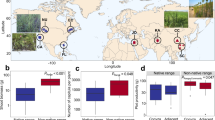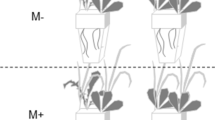Abstract
Invasions by non-native plants can alter ecosystem functions and reduce native plant diversity, but relatively little is known about their effect on belowground microbial communities. We show that invasions by knapweed (Centaurea stoebe) and leafy spurge (Euphorbia esula, hereafter spurge)—but not cheatgrass (Bromus tectorum)—support a higher abundance and diversity of symbiotic arbuscular mycorrhizal fungi (AMF) than multi-species native plant communities. The higher AMF richness associated with knapweed and spurge is unlikely due to a co-invasion by AMF, because a separate sampling showed that individual native forbs hosted a similar AMF abundance and richness as exotic forbs. Native grasses associated with fewer AMF taxa, which could explain the reduced AMF richness in native, grass-dominated communities. The three invasive plant species harbored distinct AMF communities, and analyses of co-occurring native and invasive plants indicate that differences were partly driven by the invasive plants and were not the result of pre-invasion conditions. Our results suggest that invasions by mycotrophic plants that replace poorer hosts can increase AMF abundance and richness. The high AMF richness in monodominant plant invasions also indicates that the proposed positive relationship between above and belowground diversity is not always strong. Finally, the disparate responses among exotic plants and consistent results between grasses and forbs suggest that AMF respond more to plant functional group than plant provenance.
Similar content being viewed by others
Log in or create a free account to read this content
Gain free access to this article, as well as selected content from this journal and more on nature.com
or
References
Al-Qawari AA . (2002). Relationships among nitrogen availability, vesicular-arbuscular mycorrhizae, and Bromus tectorum in disturbed rangeland sites in Colorado. PhD dissertation. Colorado State University: Fort Collins, Colorado, USA.
Altschul SF, Gish W, Miller W, Myers EW, Lipman DJ . (1990). Basic local alignment search tool. J Mol Biol 215: 403–410.
Baylis GTS . (1975). The magnolioid mycorrhiza and mycotrophy in root systems derived from it. In: Sanders F-E, Mosse B, Tinker P-B eds. Endomycorrhizas. Academic Press: London, UK, 373–389.
Brundrett M, Bougher N, Dell B, Grove T, Malajczuk N . (1996) Working with Mycorrhizas in Forestry and Agriculture. ACIAR Monograph, Issue 32 Canberra, Australia.
Busby RR, Stromberger ME, Rodriguez G, Gebhart DL, Paschke MW . (2012). Arbuscular mycorrhizal fungal community differs between coexisting native shrub and introduced annual grass. Mycorrhiza 23: 129–141.
Caporaso JG, Lauber CL, Walters WA, Berg-Lyons D, Huntley J, Fierer N et al (2010). QIIME allows analysis of high-throughput community sequencing data. Nat Methods 7: 335–336.
Davis MA, Chew MK, Hobbs RJ, Lugo AE, Ewel JJ, Vermeij GJ et al (2011). Don’t judge species on their origins. Nature 474: 153–154.
Dickie IA, Bolstridge N, Cooper JA, Peltzer DA . (2010). Co-invasion by Pinus and its mycorrhizal fungi. New Phytol 187: 475–484.
Drigo B, Pijl AS, Duyts H, Kielak AM, Gamper HA, Houtekamer MJ et al (2010). Shifting carbon flow from roots into associated microbial communities in response to elevated atmospheric CO2 . Proc Natl Acad Sci 107: 10938–10942.
Frostegård Å, Tunlid A, Bååth E . (2010). The use and misuse of PLFA measurements in soils. Soil Biol Biochem 43: 1621–1625.
Gardes M, Bruns TD . (1993). ITS primers with enhanced specificity for basidiomycetes—application to the identification of mycorrhizae and rusts. Mol Ecol 2: 113–118.
Gollotte A, van Tuinen D, Atkinson D . (2004). Diversity of arbuscular mycorrhizal fungi colonising roots of the grass species Agrostis capillaris and Lolium perenne in a field experiment. Mycorrhiza 14: 111–117.
Greipsson S, DiTommaso A . (2006). Invasive non-native plants alter the occurrence of arbuscular mycorrhizal fungi and benefit from this association. Ecological Restoration 24: 236–241.
Hart MM, Reader RJ . (2002). Taxonomic basis for the variation in the colonization strategy of arbuscular mycorrhizal fungi. New Phytol 153: 335–344.
Hawkes CV, Belnap J, D’Antonio C, Firestone MK . (2006). Arbuscular mycorrhizal assemblages in native plant roots change in the presence of invasive exotic grasses. Plant Soil 281: 369–380.
Huson DH, Bryant D . (2006). Application of phylogenetic networks in evolutionary studies. Mol Biol Evol 23: 254–267.
Johnson NC . (1993). Can fertilization of soil select less mutualistic mycorrhizae. Ecol Appl 3: 749–757.
Johnson NC, Graham JH, Smith FA . (1997). Functioning of mycorrhizal associations along the mutualism-parasitism continuum. New Phytol 135: 575–585.
Kardol P, Bezemer MT, van der Putten WH . (2009). Soil organism and plant introductions in restoration of species-rich grassland communities. Restor Ecol 17: 258–269.
Klironomos JN . (2002). Feedback with soil biota contributes to plant rarity and invasiveness in communities. Nature 417: 67–70.
Lambers H, Mougel C, Jaillard B, Hinsinger P . (2009). Plant-microbe-soil interactions in the rhizosphere: an evolutionary perspective. Plant Soil 321: 83–115.
Landis FC, Gargas A, Givnish TJ . (2004). Relationships among arbuscular mycorrhizal fungi, vascular plants and environmental conditions in oak savannas. New Phytol 164: 493–504.
Legendre P, Legendre L . (2012) Numerical Ecology (Developments in Environmental Modelling). Elsevier.
Levine JM, Vilà M, D’Antonio CM, Dukes JS, Grigulis K, Lavorel S . (2003). Mechanisms underlying the impacts of exotic plant invasions. Proc R Soc London B Biol Sci 270: 775–781.
Li W, Godzik A . (2006). Cd-hit: a fast program for clustering and comparing large sets of protein or nucleotide sequences. Bioinformatics 22: 1658–1659.
Liao C, Peng R, Luo Y, Zhou X, Fang C, Cheng J et al (2008). Altered ecosystem carbon and nitrogen cycles by plant invasion: a meta-analysis. New Phytol 177: 706–714.
Librado PJ, Rozas J . (2009). DnaSP v5: a software for comprehensive analysis of DNA polymorphism data. Bioinformatics 25: 1451–1452.
Lopes CT, Franz M, Kazi F, Donaldson SL, Morris Q, Bader GD . (2010). Cytoscape web: an interactive web-based network browser. Bioinformatics 15: 2347–2348.
Maherali H, Klironomos JN . (2007). Influence of phylogeny on fungal community assembly and ecosystem functioning. Science 316: 1746–1748.
Marler MJ, Zabinski CA, Callaway RM . (1999). Mycorrhizae indirectly enhance competitive effects of an invasive forb on a native bunchgrass. Ecology 80: 1180–1186.
Mole S, Joern A . (1993). The foliar phenolics if Nebraska sandhills prairie graminoids: between years, seasonal and interspecific variation. J Chem Ecol 19: 1861–1874.
Moora M, Berger S, Davison J, Öpik M, Bommarco R, Bruelheide H et al (2011). Alien plants associate with widespread generalist arbuscular mycorrhizal fungal taxa: evidence from a continental-scale study using massively parallel 454 sequencing. J Biogeogr 38: 1305–1317.
Mummey DL, Rillig MC, Holben WE . (2005). Neighboring plant influences on arbuscular mycorrhizal fungal community composition as assessed by T-RFLP analysis. Plant Soil 271: 83–90.
Olsson PA, Thingstrup I, Jakobsen I, Bååth E . (1999). Estimation of the biomass of arbuscular mycorrhizal fungi in a linseed field. Soil Biol Biochem 31: 1879–1887.
O’Neill EG, O’Neill RV, Norby RJ . (1991). Hierarchy theory as a guide to mycorrhizal research on large-scale problems. Environ Pollut 73: 271–284.
Öpik M, Moora M, Liira J, Zobel M . (2006). Composition of root-colonizing arbuscular mycorrhizal fungal communities in different ecosystems around the globe. J Ecol 94: 778–790.
Ortega YK, Pearson DE . (2011). Long-term effects of weed control with picloram along a gradient of spotted knapweed invasion. Rangeland Ecol Manag 64: 67–77.
Powell JR, Parrent JL, Hart MM, Klironomos JN, Rillig MC, Maherali H . (2009). Phylogenetic trait conservatism and the evolution of functional trade-offs in arbuscular mycorrhizal fungi. Proc R Soc London B Biol Sci 276: 4237–4245.
Porras-Alfaro A, Bayman P . (2011). Hidden fungi, emergent properties: endophytoes and microbiomes. Annu Rev Phytopathol 49: 291–315.
Pringle A, Bever JD, Gardes M, Parrent JL, Rillig MC, Klironomos JN . (2009). Mycorrhizal symbioses and plant invasions. Annu Rev Ecol Evol Syst 40: 699–715.
Rosendahl S, Stukenbrock EH . (2004). Community structure of arbuscular mycorrhizal fungi in undisturbed vegetation revealed by analyses of LSU rDNA sequences. Mol Ecol 13: 3179–3186.
Seifert EK, Bever JD, Maron JL . (2009). Evidence for the evolution of reduced mycorrhizal dependence during plant invasion. Ecology 90: 1055–1062.
Shah MA, Reshi ZA, Khasa DP . (2009). Arbuscular mycorrhizas: drivers or passengers of alien plant invasions. Bot Rev 75: 397–417.
Shah MA, Reshi ZA, Rasool N . (2010). Plant invasion induce a shift in Glomalean spore diversity. Trop Ecol 51: 317–323.
Smith SE, Read DJ . (2008) Mycorrhizal Symbiosis. Academic Press and Elsevier: London, UK.
Stephan A, Meyer AH, Schmid B . (2001). Plant diversity affects culturable soil bacteria in experimental grassland communities. J Ecol 88: 988–998.
Stockinger H, Kruger M, Schüßler A . (2010). DNA barcoding of arbuscular mycorrhizal fungi. New Phytol 187: 461–474.
Stukenbrock EH, Rosendahl S . (2005). Distribution of dominant arbuscular mycorrhizal fungi among five plant species in undisturbed vegetation of a coastal grassland. Mycorrhiza 15: 497–503.
Suding KN, Gross KL, Houseman GR . (2004). Alternative states and positive feedbacks in restoration ecology. Trends Ecol Evol 19: 46–53.
Tamura K, Peterson D, Peterson N, Stecher G, Nei M, Kumar S . (2011). MEGA5: Molecular evolutionary genetics analysis using maximum likelihood, evolutionary distance, and maximum parsimony. Mol Biol Evol 28: 2731–2739.
ter Braak CJF, Šmilauer P . (2002). CANOCO Reference Manual and CanoDraw for Windows User’s Guide: Software for Canonical Community Ordination 5th edn vol. 4. Microcomputer Power: Ithaca, NY, USA.
van Aarle IM, Olsson PA . (2003). Fungal lipid accumulation and development of mycelial structures by two arbuscular mycorrhizal fungi. Appl Environ Microbiol 69: 6762–6767.
van der Heijden MGA, Klironomos JN, Ursik M, Moutoglis P, Streitwolf-Engel R, Boller T et al (1998). Mycorrhizal fungal diversity determines plant biodiversity, ecosystem variability and productivity. Nature 396: 69–72.
Vandenkoornhuyse P, Ridgway KP, Watson IJ, Fitter AH, Young JPW . (2003). Co-existing grass species have distinctive arbuscular mycorrhizal communities. Mol Ecol 12: 3085–3095.
van der Putten WH, Klironomos JN, Wardle DA . (2007). Microbial ecology of biological invasions. ISME J 1: 28–37.
van Kleunen M, Weber E, Fischer M . (2010). A meta-analysis of trait differences between invasive and non-invasive plant species. Ecol Lett 13: 235–245.
Vogelsang KM, Bever JD . (2009). Mycorrhizal densities decline in association with nonnative plants and contribute to plant invasion. Ecology 90: 399–407.
Waldrop MP, Zak DR, Blackwood CB, Curtis CD, Tillman D . (2006). Resource availability controls fungal diversity across a plant diversity gradient. Ecol Lett 9: 1127–1135.
Wilson GW, Hartnett DC . (1998). Interspecific variation in plant responses to mycorrhizal colonization in tallgrass prairie. Am J Bot 85: 1732–1738.
Zhang Q, Yang R, Tang J, Yang H, Hu S, Chen X . (2010). Positive feedback between mycorrhizal fungi and plants influences plant invasion success and resistance to invasion. PLoS ONE 5: e12380.
Acknowledgements
We thank land managers and ranchers for providing sample sites, Lauren Stoffel and Alexii Cornell for help during sampling, PCR and plant identification and Jill Castoe, Scott Hunicke-Smith, Weizhong Li and Sitao Wu for guidance with 454-sequencing and associated analyses. We also thank Roger Koide, Dean Pearson, John Maron, Lauren Waller and three anonymous reviewers for their comments on the manuscript, Dan Mummey for advice regarding PCR and statistics and MPG Operations for funding.
Author information
Authors and Affiliations
Corresponding author
Additional information
Supplementary Information accompanies this paper on The ISME Journal website
Supplementary information
Rights and permissions
About this article
Cite this article
Lekberg, Y., Gibbons, S., Rosendahl, S. et al. Severe plant invasions can increase mycorrhizal fungal abundance and diversity. ISME J 7, 1424–1433 (2013). https://doi.org/10.1038/ismej.2013.41
Received:
Revised:
Accepted:
Published:
Issue date:
DOI: https://doi.org/10.1038/ismej.2013.41
Keywords
This article is cited by
-
Temporal dynamics of plant−soil feedback and related mechanisms depend on environmental context during invasion processes of a subtropical invader
Plant and Soil (2023)
-
Changes in arbuscular mycorrhizal fungal communities, mycorrhizal soil infectivity, and phosphorus availability under Chromolaena odorata (Asteraceae) invasions in a West-African forest-savanna ecotone
Mycorrhiza (2023)
-
Co-occurring tree species drive arbuscular mycorrhizal fungi diversity in tropical forest
International Microbiology (2023)
-
Characterization of the arbuscular mycorrhizal fungal community associated with rosewood in threatened Miombo forests
Mycorrhiza (2023)
-
Richness of arbuscular mycorrhizal fungi increases with ecosystem degradation of temperate eucalypt woodlands
Plant and Soil (2023)



